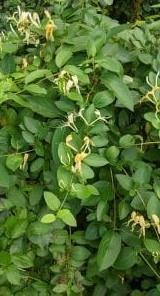By Christine Gelley
Honeysuckle is a commonly found plant that often draws attention of passersby with its pleasantly fragrant blossoms from April to July. The sweet nectar inside its tubular flowers is edible by many animals and even people. There are over 180 known honeysuckle species in the northern hemisphere. It’s beauty and fragrance lead to the introduction of many non-native honeysuckle species to North America in the 1800s primarily for ornamental use. Despite the sweetness it adds to the air, the impacts it has on our environment are certainly not sweet.

You can pick the flowers, but please destroy the honeysuckle plant!
Unfortunately, four of these introduced species are extremely aggressive in our landscapes and have created an imbalance in natural systems due to their ability to outcompete native plants for resources. The types of honeysuckles which are damaging to these spaces are Japanese honeysuckle, which is a vining type, and three bush type honeysuckles- amur, morrow’s, and tartarian. Some species form dense thickets of shrubs and some spread with vast creeping vines that can strangle neighboring plants. These honeysuckle species are commonly found in pastures, woodlands, reclaimed sites, and waste spaces.
Because of their invasive status in Ohio, it is every landowners’ legal responsibility to control their spread. Although they can be used as a food source for some wildlife, allowing their unimpeded growth reduces the success of other plants that produce nuts and berries with greater nutritional value for birds, insects, and mammals. The reduction of native plant species leads to a reduction in the diversity of native wildlife as well.
Honeysuckles are easy to identify by their aroma and their flowers. On all four invasive species the flowers change to a buttery-yellow color as they age and resemble clusters of popped popcorn. Although color can vary by species, most often newly blooming flowers are white and grow in pairs along the plant’s stems. Differences between species can be defined by closely examining the leaves, stems, and berries. The easiest way to distinguish Japanese honeysuckle from the two common vining native species- trumpet and wild honeysuckle, is to compare berry color in the fall. Japanese honeysuckle berries will appear black while trumpet and wild honeysuckle berries appear red. However, the bush type honeysuckles also have red berries, so berry color alone cannot confirm the plant’s identity. In my experience, almost all the honeysuckles we encounter are one of the four invasive types.
For simplicity, recommendations for honeysuckle species are typically communicated for vining honeysuckle and bush honeysuckle, because treatment methods and identification features of the bush types are very similar. Honeysuckles reproduce by seed, which is often spread by birds, and by creeping stems and root sprouts. Thus, the most effective treatment methods for honeysuckle include removing or killing the root tissue.
Mechanical control for small infestations can be employed by digging or pulling plants up by the roots, tillage, mowing if plants are small, burning, or by using land clearing machinery in cases where large thickets have formed. Multiple herbicides provide 80% or better control of honeysuckle depending on the method of application and the time of year. These include products containing metsulfuron methyl, dicamba, 2,4-D, and/or triclopyr, while glyphosate products are only 60-70% effective on honeysuckle.
Foliar application with these products is often preferred in the late-fall because honeysuckles retain green leaves longer than most other surrounding plants making identification easier and any herbicide overspray less damaging to surrounding desirable plants. Honeysuckles can also be treated with basal bark or cut stump treatments. Basal bark treatments can be effective anytime that temperatures are above freezing, except during spring sap flow. Cut stump treatment can be effective in the summer, fall, or winter. Springtime treatment is least effective because herbicides are less likely to be translocated to the root tissue at that time and the plant will easily regrow from the unharmed root system.
With honeysuckle blooming now across the state, I encourage admirers to pick all the flowers they want to use in arrangements for their tables and loved ones, because every flower removed stops seed development. After enjoying the flowers, remember to return to execute the remainder of the plant in order to help preserve the environment for our beneficial natives!
Source : osu.edu